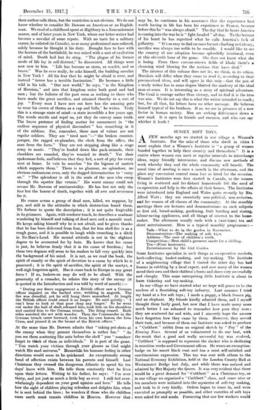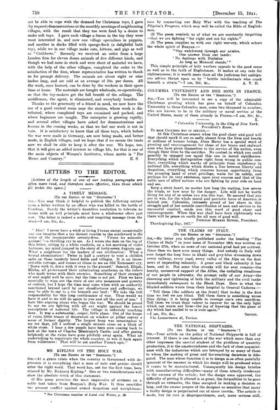SUSSEX SOFT TOYS.
AFEW months ago we started in our village a Women's Institute. For the sake of those who dwell in cities I must explain that a Women's Institute is "a group of women banded together to help their country and themselves." It is a centre where women can meet at regular intervals to interchange ideas, enjoy friendly intercourse, and discuss new methods of work whereby they and the whole community will benefit. The usual time of meeting is once a month in the afternoon, and the place any convenient central room lent or hired for the occasion. Women's Institutes were first started in Canada, as the women living in scattered and far distant homesteads felt the need of co-operation and help in the affairs of their homes. The Institutes were introduced into England and Wales quite recently by DIra. Alfred Watt ; they are essentially non-political, non-sectarian, and for women of all classes of the community. At the monthly meetings there are lectures and demonstrations on such subjects as first aid, bread-making, gardening, fruit bottling and storing, labour-saving appliances, and all things of interest to the home- maker. The afternoon usually ends with a (war-time) tea sad short entertainment. Here is a typical monthly programmer- Talk—What to do in the garden in November.
Demonstration—The making of soft toys. Address—The care of children's teeth. Competition—Best child's garment made for a shilling. Tea—(Four hostesses).
Entertainment by the Girl Guides.
Some Institutes specialize in such things as co-operative marketa„ herb-eollecting, basket-making, and toy-making. The Institute of a neighbouring village that I visited the other day has had lessons in cobbling by a local expert, and now many of the women mend their own and their children's hoots and shoes very successfully and cheaply. This same enterprising little Institute is about to learn tinkering and toy-making.
In our village we have started what we hope will prove to be the nucleus of a flourishing soft-toy industry. Last summer I tried my hand at a few soft toys ; I made a puppy, a black Sussex pig, and an elephant. My friends kindly admired them, and I myself thought them fairly good, but now that I have made many more much better I am ashamed to remember how poor they .were: they are scattered far and wide, and I sincerely hope the owners have forgotten how they came by them. However, they served their turn, and because of them our Institute was asked to preduce " Cuthbert " rabbit from an original sketch by " Poy " of the Evening News. Several of as volunteered to do our beat, with the result that a good and really successful toy was evolved. " Cuthbert " is supposed to represent the slacker who is sheltering in munition works and Government offices. He wears an exemption- badge on his smart black coat and has a most self-satisfied and sanctimonious expression. This toy was sent with others to the National Economy Exhibition, held at the London County Hall at Westminster Bridge last July, and while there wee noticed and admired by Her Majesty the Queen. It was very evident that there would be a great demand for " Cuthbert " as a Christmas toy, an in our village we organized a "Cuthbert" class, and some nine or ten members were initiated into the mysteries of soft-toy making, and took to it very kindly. Orders began to creme in, and were executed as promptly as possible, and other varieties of soft toys were asked for and- made. Foreseeing that our few workers would not be able to cope with the demand for Christmas toys, I gave by request) demonstrations at the monthly meetings of neighbouring villages, with the result that they too were fired, by a desire to make soft toys. I gave each village a.lesson in the toy they were most interested in, and now one village specializes in puppies, and another in ducks filled with sponge-flock (a delightful bath toy), while we in our village make oats, kittens, and pigs as well as " Cuthberts." Recently we received an order from a large London firm for eleven dozen animals of five different kinds, and though we had none in stock and were short of material we have, with the help of the other villages, completed the order to the satisfaction of the firm, whose representative has written to thank us for prompt delivery. The animals are about eight or nine inches long, and are sold at an average of 24s. per dozen. All. the work, once learned, can be done by the workers in their spare. time at home. The materials are bought wholesale, co-operatively, so that the toy-makers get the full benefit of the sellings. The middleman, the agent, is eliminated, and everybody benefits.
Thanks to the generosity of a friend in need, we now have the. use of a good central room near the station, where work is dis- tributed, where completed toys are examined and packed, and where beginners are taught. The enterprise is growing rapidly, and several other villages have asked for demonstrations and lessons in the coming weeks, no that we feel our work is not in vain. It is satisfactory to know that all these toys, which before. the war were made in Germany, are now being made, and better' made, in English villages, and we hope that if we secure the trade now we shall be able to keep it after the war. We hope, too, that it will give an added interest to village life, for that is one of the main objects of Women's Institutes, whose motto is" For



































 Previous page
Previous page